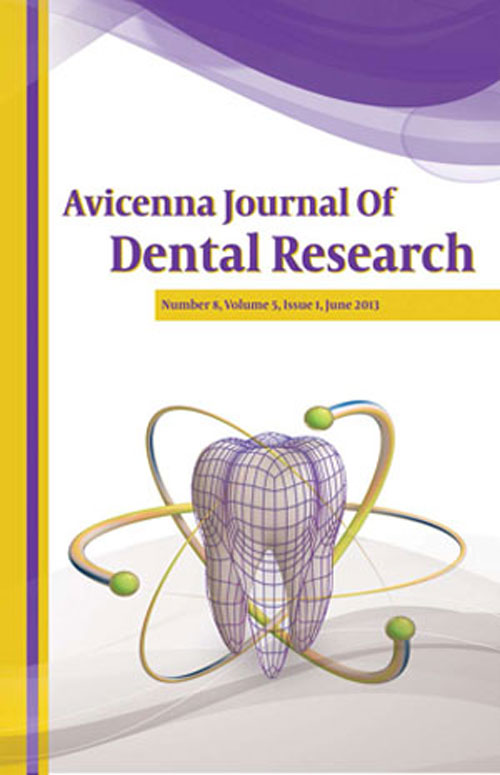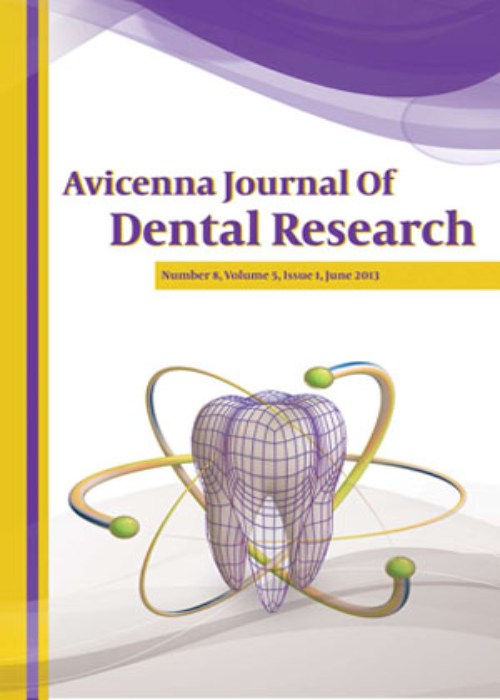فهرست مطالب

Avicenna Journal of Dental Research
Volume:8 Issue: 4, Dec 2016
- تاریخ انتشار: 1395/10/08
- تعداد عناوین: 8
-
-
Page 1BackgroundThe first commercial system for digital radiography was introduced in 1987, and it has evolved a great deal since then. Currently, it is possible to enhance images in digital radiography..ObjectivesThe aim of this study is to evaluate the diagnostic accuracy of image enhancement in direct digital radiography as it relates to interproximal carries assessment..Materials And MethodsFollowing extraction, 50 human teeth were kept in acidic gel (methyl cellulose acetate buffer PH = 4.8) for 42 days at 37°C to cause caries before mounting. Direct digital radiography was then taken. Two filters were used: sharpen and emboss. Three radiologists evaluated the images with two weeks interval. The histologic assessments were gold standard. Additionally, SPSS 20 was used to draw an ROC curve and calculate AUC. Cohens kappa and interclass correlation coefficient (ICC) were used to measure intra- and inter-observer reliability..ResultsFor the emboss filter, sensitivity was 95%, specificity was 100%, and accuracy was 96%. For the sharpen filter, sensitivity was 88%, specificity was 100%, and accuracy was 90%. Also, the AUC for the emboss filter was 0.97, and it was 0.94 for the sharpen filter. Cohens simple kappa was in the range of excellent..ConclusionsUsing these filters in intra-oral direct digital radiography (especially the emboss filter) can help some clinicians to increase diagnostic accuracy in the assessment of inter proximal caries of posterior teeth..Keywords: Dental Caries, Digital Dental Radiography, Image Enhancement, Sensitivity, Specificity
-
Page 2BackgroundJaws spiral tomography and panoramic radiography have wide applications in dentistry, and the parotid gland is one of the most sensitive organs of the head and neck..ObjectivesThe aim of this study was to evaluate and compare the parotid-absorbed dose in spiral tomography and panoramic radiographs using a thermoluminescent dosimeter..Materials And MethodsA radiation analog dosimetry phantom was placed in a Cranex Tome radiograph device, and a parotid absorbed dose was measured in both techniques. Thermoluminescent dosimeters were placed bilaterally in the parotid region (on the tube side and the opposite side). Spiral tomography dosimetry was done for the upper and lower jaws in the anterior and posterior regions. Each region contained four slices of 2 mm and four slices of 4 mm in thickness. The results were analyzed by a Wilcoxon test..ResultsFor the tube side parotid, the average absorbed doses in spiral tomography of the anterior and posterior parts of the maxilla and mandible, with the 2 mm slice thickness, were 1.70/1.40 and 1.65/1.60 mGy, respectively. The average absorbed doses with the 4mm slices were 1.65/1.70 and 1.75/1.57 mGy, respectively. For the opposite parotid, the average absorbed dose in spiral tomography of the anterior and posterior parts of the maxilla and mandible, with the 2 mm slice thickness, were 1.40/1.30 and 1.40/1.67 mGy, respectively. The average absorbed doses with the 4mm slices were 1.50/1.66 and 1.40/1.50 mGy, respectively. The average absorbed dose of the panoramic radiograph was 1.40 mGy..ConclusionsThere was no statistically significant difference in the parotid absorbed dose between spiral tomography and a panoramic radiograph (P value = 0.18). The overall results of this study were similar to other studies..Keywords: Dosimetry, Panoramic Radiography, Spiral Tomography
-
Page 3BackgroundProper and timely post-exposure prophylaxis (PEP) after needle stick exposure to high-risk body fluids significantly reduces occupational transmission..ObjectivesThis study was conducted with the aim of demonstrating the level of knowledge and practice amongst general dental practitioners in Hamadan city, Iran in 2013 - 14, in terms of prevention after dealing with blood-borne pathogens..Materials And MethodsIn this descriptive cross-sectional study, all general dental practitioners in Hamadan provided information on their preventative approach after dealing with blood-borne pathogens, via a pretested self-administered questionnaire in three parts. The first part consisted of demographic features, the second part (15 questions) demonstrated knowledge level, and the last part (5 questions) measured dentists practice in terms of prevention after dealing with blood-borne pathogens. Data from the 82 questionnaires was analyzed using SPSS 16 software, Mann-Whitney, and chi-square test (α = 0.05)..ResultsThe mean score of knowledge was 7.9 ± 2.522 (from a possible total score of 15). The lowest and highest scores were 2 and 14. 60.7% of the dentists had trained their staff; 58.8% of them accepted infected patients, and 65.9% had attended a PEP workshop. It was found that, of the demographic features, only gender had a significant correlation with level of knowledge (P = 0.0001)..ConclusionsThis study revealed a low level of knowledge and practice regarding post-exposure prophylaxis, with the mean score of some respondents being below 50%..Keywords: Post, Exposure Prophylaxis, Knowledge, Practice, General Practitioners
-
Page 4BackgroundFluoride plays an important role in preventing dental caries. Low fluoride concentrations cannot prevent dental caries, but ingestion of very high concentrations of fluoride during enamel development and maturation could lead to fluorosis. Fluoridation of drinking water is the most effective and inexpensive method for preventing caries. The mandated concentration of fluoride incorporated into drinking water should consider the mean temperature of each region..ObjectivesThe aim of the present study was to evaluate the prevalence of fluorosis in children aged 6 - 12 in Mariwan and Behbahan and determine the fluoride content of drinking water in these two towns..Materials And MethodsIn the present descriptive and cross-sectional study, 13 water samples were taken from homes in Behbahan, 1 sample from the towns water reservoir, 10 samples from homes in Mariwan (5 samples for each reservoir) and 1 sample each from the towns 2 reservoirs. The 26 samples (23 from homes and 3 from reservoirs) were taken in polyethylene containers. The SPANDS colorimetric technique was used to determine fluoride content. Homes that used home-based water purification systems were excluded from the study. In addition, 128 students (62 girls and 66 boys) in Behbahan and 90 students in Mariwan were randomly selected. Deans index was used to determine dental fluorosis. The mean yearly temperatures of the two towns were obtained from the metrological bureaus of the two towns..ResultsThe means fluoride content of water in Behbahans reservoir and Mariwans reservoirs 1 and 2 were 0.7, 0.24 and 0.036 ppm, respectively. The mean fluoride content of Behbahans home waterlines and in the relevant home waterlines of reservoirs 1 and 2 in Mariwan were 0.67, 0.218, and 0.054 ppm, respectively. There were no significant differences between the relevant reservoirs. The prevalence of fluorosis in Behbahan was as follows: 84.4% healthy, 10.9% questionable, 1.6% very mild, 2.3% mild, and 0.8% moderate. In Mariwan, the prevalence in areas related to reservoir 1 was 96.7% healthy and 3.3% questionable; in areas related to reservoir 2 it was 94.4% healthy and 5.6% questionable..ConclusionsThe fluoride content of drinking water in reservoirs and at homes was below the optimal level in Mariwan. No differences were observed from the standard levels in Behbahan. There were no differences in fluoride content of water in reservoirs and in home pipelines, indicating no tangible changes in fluoride content from the reservoirs to the homes. In neither of the towns was severe fluorosis observed. There was no significant difference in the prevalence and severity of fluorosis between genders..Keywords: Drinking Water Fluoride Content, Fluorosis, Dental, Temperature
-
Page 5BackgroundTracking various biomarkers in serum, gingival crevicular fluid (GCF), and saliva has been introduced as a diagnostic tool for periodontal disease detection..ObjectivesThe aim of this study was to compare salivary lactate dehydrogenase (LDH) levels in subjects with periodontal disease and levels in subjects without periodontal disease..Materials And MethodsIn this case-control study, 170 patients at Hamadan faculty of Dentistry, including patients with periodontal disease and patients with normal periodontium, were selected and divided into test and control groups. Unstimulated saliva was collected in the same situation from the test and control groups. Each saliva sample was analyzed to measure salivary LDH level on the day of collection, by using commercially available kits according to the manufacturers instructions. A statistical T-test was employed to evaluate significant differences among groups..ResultsThe mean LDH levels in the test and control groups were 1071.67 ± 731.004 and 550.91 ± 217.215, respectively. As the level of statistical significance was set at PConclusionsSalivary LDH levels can be used as marker of periodontal disease for screening periodontitis in large populations..Keywords: Periodontal Disease Biomarkers, Lactate Dehydrogenase, Diagnostic Indicator, Periodontal Diagnosis, Periodontal Diseases, Periodontitis, Saliva
-
Page 6BackgroundAcute leukemia is a malignant, rapidly progressive disease of the bone marrow and blood that most commonly occurs in children. Abnormalities of blood caused by leukemia and also accumulation of leukemic cells in different parts of the oral cavity cause a wide spectrum of oral manifestations..ObjectivesThe current study aimed to estimate the incidence of leukemia among children in Tehran and evaluate oral manifestations of the disease as potential diagnostic markers..
Patients andMethodsIn this retrospective cross-sectional study, medical records of children younger than 12 years referred to Mofid hospital, Ali-Asghar hospital and Childrens medical center from 1997to 2011 were retrieved from the hospital archives and evaluated. Records of 100 patients with leukemia were randomly selected for evaluation. The obtained data were transferred to the questionnaires. Data were analyzed using SPSS version 11.5 and Chi-square test..ResultsOf the 3,789 children younger than 12 years referred to the hematology department of Tehran pediatric hospitals from 1997 to 2001, 1,372 had acute leukemia, put of which 94% had acute lymphoblastic leukemia and 5% had acute myeloid leukemia. Boys aged 5 - 10 years made up 69% of the acute leukemia cases. The most common oral manifestation was gingival bleeding and petechiae. The most important disease other than leukemia was anemia in the patients..ConclusionsThe present study highlights the role of dentists to detect oral manifestations of leukemia and their possible role in early diagnosis of patients with the disease..Keywords: Ecchymosis, Gingival Bleeding, Leukemia, Oral Manifestation, Petechiae -
Page 7BackgroundImplant-supported overdentures could have many benefits for patients, especially in the lower jaws. As a matter of fact, the most common reason for prescribing mandibular overdenture is dissatisfaction of patients with mandibular dentures usually because of a lack of retention, stability and function and speech difficulties. On the other hand, patient's expectations of overdenture treatments are their main disadvantage..ObjectivesThe aim of this study was to evaluate the satisfaction of patients who had received mandibular implant supported overdenture treatment with different number of implants..
Patients andMethodsThis study was a descriptive cross-sectional study. Twenty-five patients with a mean age of 62.7 years who had received mandibular implant supported overdenture treatment at the dental school of Hamadan University of Medical Sciences were enrolled. Among these patients, six had overdentures supported by one implant, nine had overdentures supported by two implants, two had overdentures supported by three implants, five had overdentures supported by four implants and three had overdentures supported by five implants. The visual analogue scale (VAS) questionnaire was used to evaluate the general satisfaction, comfort, esthetic, fitness, satisfaction of chewing and social communication, and the data was analyzed by the analysis of variance (ANOVA) test..ResultsAll patients in all five groups were satisfied with their overdentures; however there was no significant relationship between the number of implants and fitness (P = 0.446), esthetic (P = 0.843), comfort (P = 0.805), satisfaction of chewing (P = 0.133), social communication (P = 0.322) and general satisfaction (P = 0.493)..ConclusionsThere was no difference in satisfaction level of patients who had received mandibular overdentures with different number of implants..Keywords: Implant, Mandible, Overdenture, Satisfaction -
Page 8IntroductionA residual cyst is a periapical cyst persisted after its associated tooth had been extracted..Case PresentationA 59-year-old Iranian man complaining of a dull pain in his left side of the mandible after falling down one month ago was referred to the department of oral and maxillofacial pathology, Hamadan University of Medical Sciences, Iran. Panoramic film revealed a radiolucent lesion and fracture of the mandible at the right side. An excisional biopsy was obtained. Based on the histopathologic findings, residual cyst was diagnosed..ConclusionsWe reported a rare case of large residual cyst. Dental practitioners should consider this lesion in the differential diagnosis of radiolucent lesions of the jaw bone..Keywords: Cysts, Tooth, Odontogenic Cyst, Calcifying


